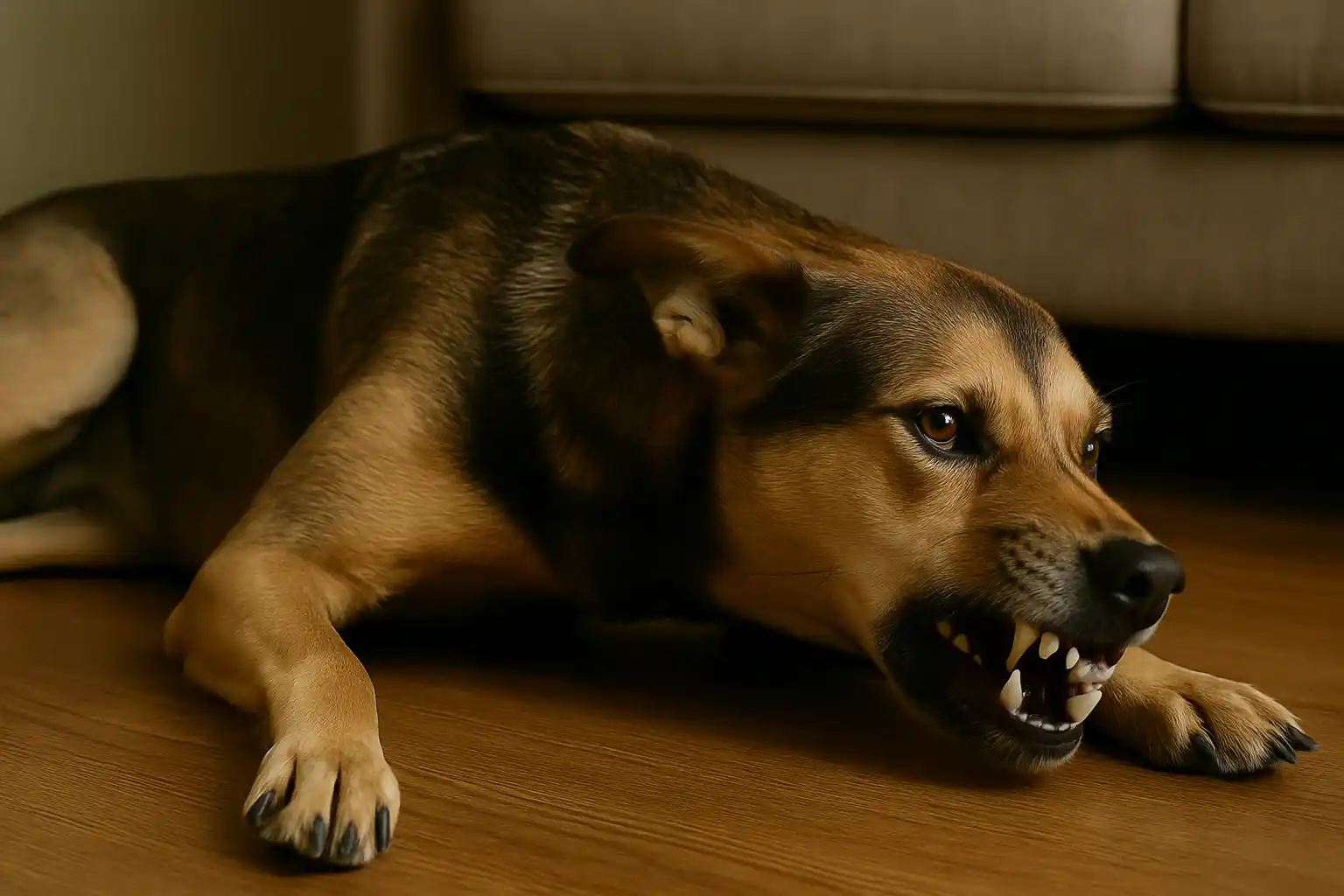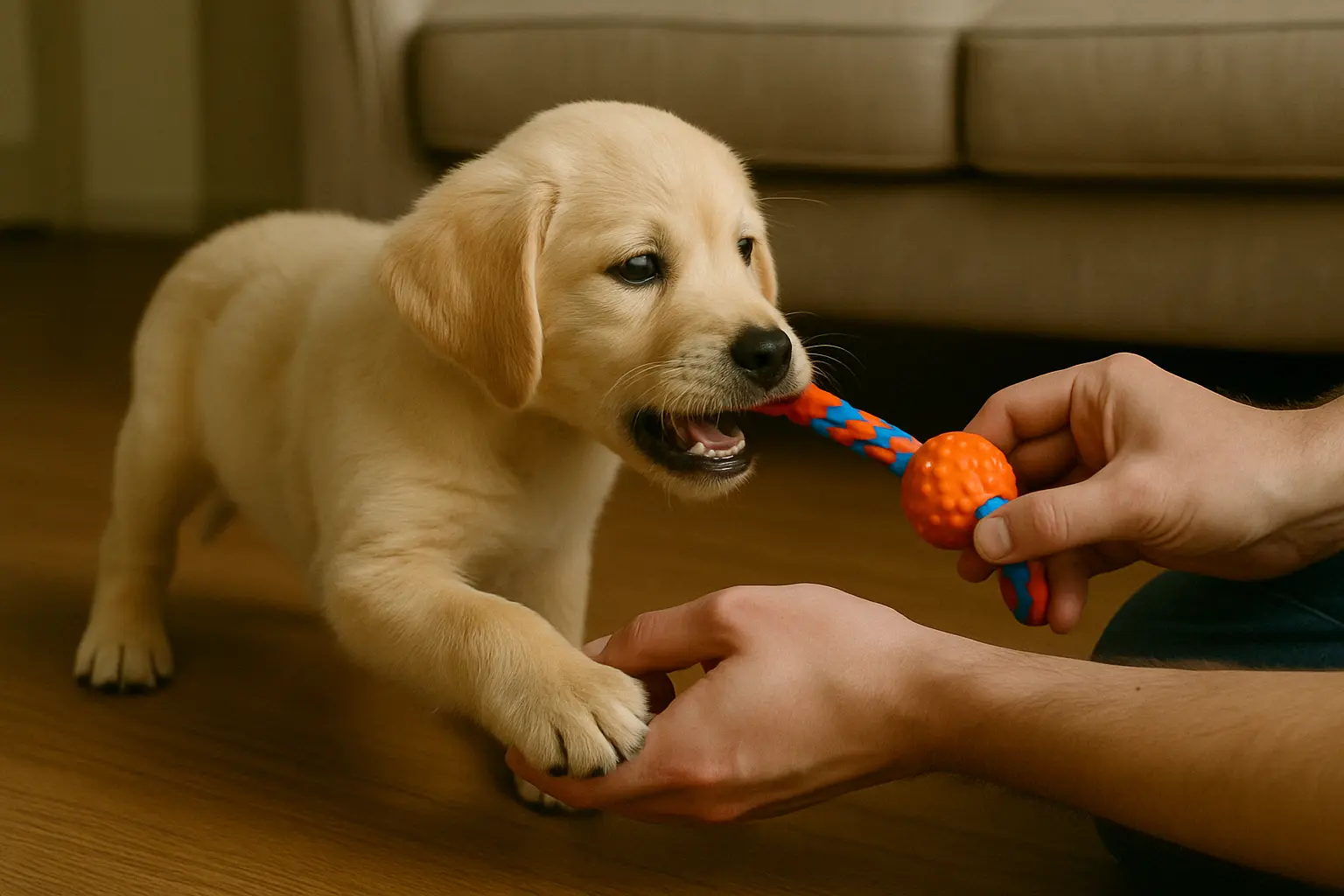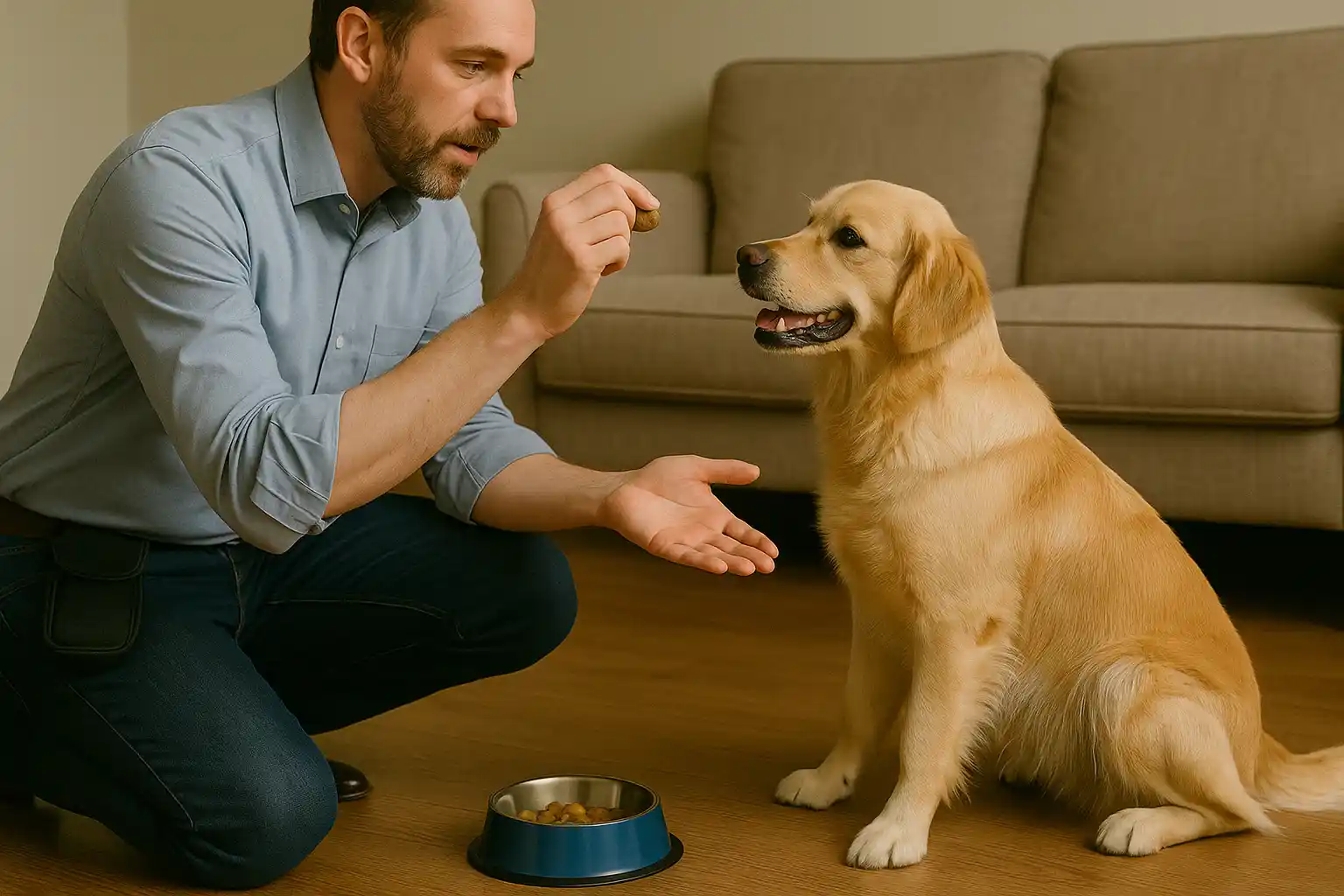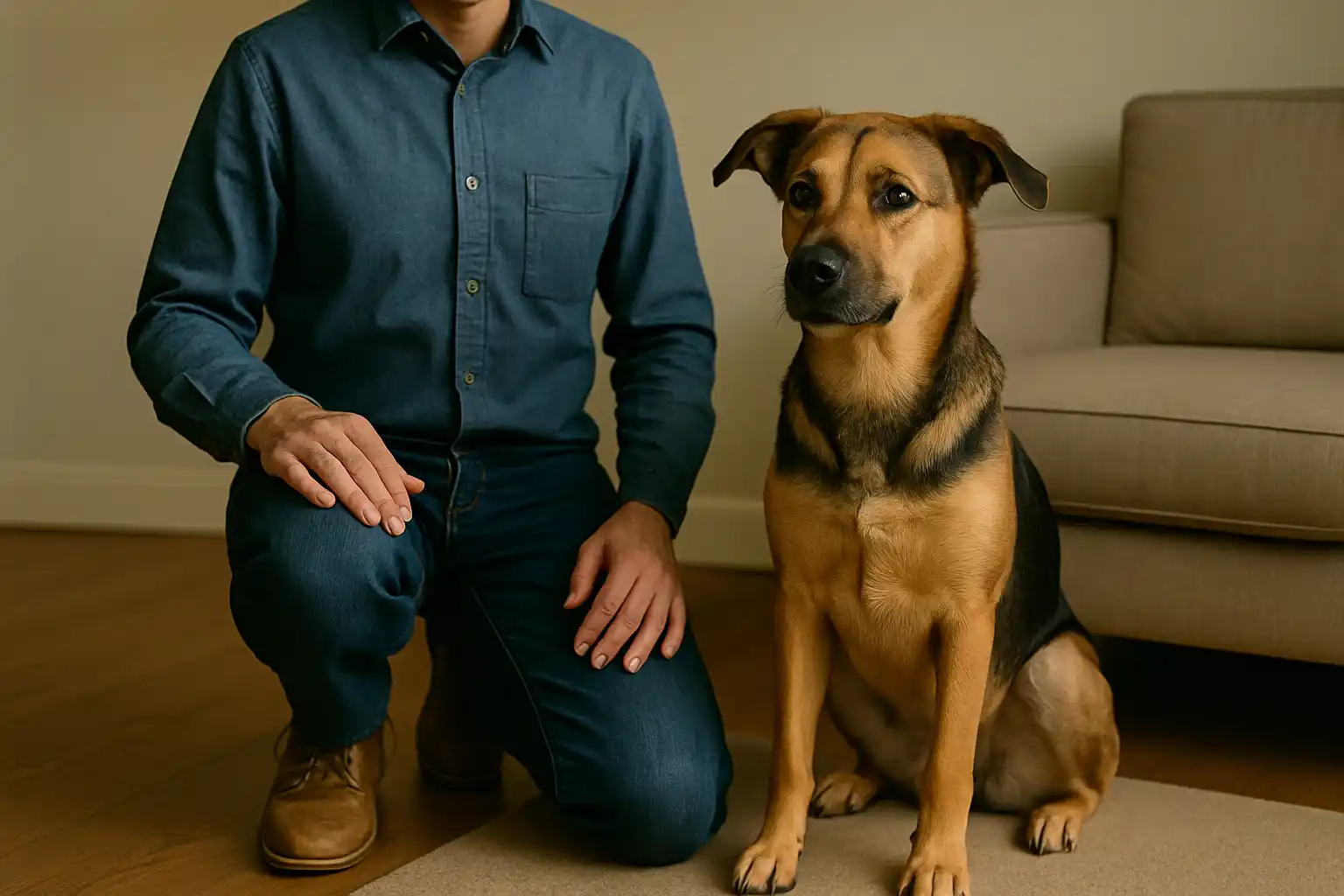Learning how to teach dogs not to bite is essential for every dog owner’s safety and peace of mind. This comprehensive guide explores effective training techniques, prevention strategies, and behavioral insights to help you address and eliminate biting behavior in both puppies and adult dogs.
As a certified dog trainer with over 15 years of experience working with aggressive and difficult cases, I’ve seen firsthand how proper training can transform even the most challenging biting behaviors. Understanding how to teach dogs not to bite requires patience, consistency, and knowledge of canine psychology. Whether you’re dealing with a mouthy puppy or addressing more serious aggression in an adult dog, this guide provides the expert guidance you need.
I’ve successfully helped hundreds of families create safer relationships with their dogs, and I’m sharing the most effective, science-backed methods to address biting behavior. From understanding why dogs bite to implementing step-by-step training protocols, you’ll find practical advice that works in real-world situations with real dogs.
Understanding Dog Behavior Related to Biting
Before implementing solutions for how to teach dogs not to bite, it’s crucial to understand the various reasons dogs exhibit this behavior. Dogs bite for different reasons at different life stages, and proper identification of the cause is the first step toward effective training.
Why Puppies Bite
Puppy biting (also called mouthing) is primarily developmental:
- Teething discomfort: Puppies between 3-6 months are often dealing with painful teething
- Exploration: Puppies learn about their world through their mouths
- Play behavior: Puppies bite during play as they would with littermates
- Boundary testing: Young dogs test limits through nipping behavior
- Lack of bite inhibition: Young puppies haven’t yet learned to control bite pressure
I worked with a 4-month-old Labrador puppy whose family was concerned about his “aggressive biting.” After assessment, it became clear this was normal exploratory mouthing that simply needed proper direction and training.
Why Adult Dogs Bite
Adult dog biting typically falls into different categories:
- Fear-based: Reaction to perceived threats or anxiety
- Resource guarding: Protecting food, toys, people, or territory
- Pain-related: Biting due to injury or medical conditions
- Frustration: Inability to access desired resources
- Redirected aggression: When aroused by one trigger but biting something else
- Predatory behavior: In some cases, smaller animals or fast movements trigger predatory responses
A German Shepherd I worked with had begun biting visitors entering the home. After careful behavioral analysis, we identified fear aggression triggered by a specific negative experience with a delivery person. Understanding this root cause was essential in implementing the right approach to how to teach dogs not to bite in this specific context.

Warning Signs Before Biting
Learning to recognize pre-bite signals is a critical aspect of how to teach dogs not to bite:
- Body stiffening: Rigid posture indicates heightened arousal
- Whale eye: Showing whites of the eyes
- Raised hackles: Hair standing up along the neck and back
- Growling or snarling: Obvious vocal warnings
- Lip lifting: Showing teeth as a warning
- Hard staring: Fixed, intense gaze
- Sudden freezing: Complete stillness before action
Understanding the “ladder of aggression”—the progression from subtle signs to actual biting—allows you to intervene early. Many owners miss the subtle communications before a bite occurs, which is why education about body language is a fundamental aspect of how to teach dogs not to bite.
Methods for Prevention of Biting in Puppies
Knowing how to teach dogs not to bite starts with proper training during puppyhood. Implementing these strategies early creates a foundation for a well-mannered adult dog.
Bite Inhibition Training
Teaching puppies to control their bite pressure is the first step:
- Allow gentle mouthing initially: Don’t stop all mouthing immediately
- Use feedback for hard bites: When your puppy bites too hard, give a high-pitched “ouch!” and briefly stop play
- Gradually increase sensitivity: As your puppy learns to be gentler, respond to increasingly softer pressure
- Progress to no teeth on skin: Eventually, any tooth contact ends playtime temporarily
This graduated approach mimics how puppies learn from littermates and is the most effective way for how to teach dogs not to bite too hard before teaching them not to bite at all.
Appropriate Toy Substitution
Consistently redirecting teeth from hands to toys is essential:
- Keep toys accessible: Have appropriate chew toys within reach at all times
- Immediate replacement: When teeth touch skin, immediately offer a toy
- Praise for correct chewing: Enthusiastically reward appropriate toy chewing
- Consistency: Ensure all family members follow the same protocol
I worked with a family whose Border Collie puppy was biting their children during play. By implementing a “toys everywhere” strategy—placing appropriate chew items in every room—they saw a 70% reduction in mouthing behavior within just one week.

Managing Puppy Environment
Environmental management is an often overlooked aspect of how to teach dogs not to bite:
- Provide adequate exercise: Tired puppies are less mouthy
- Ensure sufficient mental stimulation: Bored puppies often resort to biting for attention
- Create appropriate play sessions: Structured play with rules prevents overexcitement
- Schedule regular naps: Overtired puppies often display increased biting
- Avoid rough play: Wrestling and chasing games can trigger mouthing
A Golden Retriever puppy I worked with showed significant improvement in biting behavior when his family implemented a structured daily routine with defined exercise periods, training sessions, and mandatory rest times in his crate.
Teaching “Leave It” and “Drop It”
These fundamental commands are essential tools for how to teach dogs not to bite:
Leave It Training Steps:
- Hold a low-value treat in your closed fist
- Let your puppy sniff and lick your hand, but don’t open it
- The instant your puppy backs away, mark with “Yes!” and reward with a different treat
- Gradually progress to open-hand presentations, then floor placement
- Add the verbal cue “Leave it” before presenting the item
Drop It Training Steps:
- Offer your puppy a toy to hold
- Present a high-value treat close to their nose
- When they release the toy for the treat, say “Drop it”
- Reward with the treat and eventually return the toy
- Practice with various toys of increasing value
Read more: How Long Does Puppy Biting Phase Last
Techniques for Correcting Biting in Adult Dogs
When addressing how to teach dogs not to bite in adult dogs, different approaches are often needed depending on the underlying cause of the biting behavior.
Addressing Fear-Based Biting
For dogs biting out of fear:
- Identify triggers: Determine exactly what situations cause fear responses
- Create distance: Maintain safe distance from triggers during training
- Counter-conditioning: Pair triggers with positive experiences
- Desensitization: Gradually increase exposure to triggers while maintaining calm behavior
- Build confidence: Use confidence-building exercises and training
A rescue Shepherd mix I worked with would bite when strangers attempted to pet him. We implemented a structured counter-conditioning program where strangers tossed treats from a distance without eye contact or approach. Over three months, we gradually decreased distance while building positive associations.
Managing Resource Guarding
For dogs biting to protect resources:
- Prevent practice: Manage the environment to avoid triggering situations
- Trading games: Teach your dog that surrendering items results in even better rewards
- “Drop it” and “Leave it”: Reinforce these commands with high-value rewards
- Hierarchy of resources: Begin with low-value items before addressing high-value guarding
- Structured resource access: Implement predictable patterns for resource distribution
Remember that severe resource guarding requires professional help, as incorrect handling can worsen the behavior.

Interrupting the Biting Cycle
Breaking established patterns is crucial when learning how to teach dogs not to bite:
- Identify precursors: Learn your dog’s specific pre-biting signals
- Redirect before escalation: Intervene at the first sign of arousal
- Pattern interruption: Use a previously trained, incompatible behavior (like “go to place”)
- Avoid punishments: Punitive responses often increase fear and aggression
- Consistent response protocol: Ensure all family members respond the same way
Medical Considerations
Always rule out medical causes when addressing how to teach dogs not to bite:
- Pain assessment: Dogs in pain may bite when touched
- Neurological issues: Some seizure disorders or neurological conditions can cause biting
- Age-related cognitive changes: Senior dogs may develop confusion leading to biting
- Hormone imbalances: Thyroid issues can contribute to behavior changes
I once worked with a normally gentle Cocker Spaniel who had suddenly started biting during handling. A veterinary exam revealed an ear infection causing significant pain. After medical treatment, the biting behavior resolved completely.
Using Positive Reinforcement to Reduce Biting
Positive reinforcement is the cornerstone of effective strategies for how to teach dogs not to bite. This approach focuses on rewarding desired behaviors rather than punishing unwanted ones.
Reward-Based Alternative Behaviors
Teaching and rewarding incompatible behaviors:
- “Four on the floor”: Reward your dog for keeping all paws on the ground instead of jumping and nipping
- “Go to place”: Train your dog to go to a designated mat or bed when excited
- Targeting exercises: Teach your dog to touch their nose to your hand instead of biting
- Structured greetings: Establish specific greeting protocols that prevent excitement biting
A Cattle Dog mix I worked with would nip visitors’ heels when they entered the home. We trained a strong “go to place” command and rewarded the dog for remaining on his mat when visitors arrived. Within three weeks, he was automatically going to his place when the doorbell rang.
Marking and Rewarding Calm Behavior
Positive reinforcement for appropriate behavior:
- Capture calmness: Reward your dog when they’re naturally calm
- Shape gradually: Reward progressively longer periods of gentle behavior
- Use verbal markers: A consistent “Yes” or clicker helps pinpoint exact moments of good behavior
- Variable rewards: Unpredictable rewards strengthen behaviors more effectively than predictable ones
Clicker Training Applications
Clicker training is particularly effective for how to teach dogs not to bite:
- Precision: Marks the exact moment your dog chooses not to bite
- Clear communication: Helps dogs understand exactly what behavior earned the reward
- Distance work: Allows marking good behavior even at a distance
- Emotional neutrality: Removes emotional responses that can escalate situations

Reward Quality and Timing
Effective reinforcement depends on:
- High-value rewards: Use especially motivating treats for challenging situations
- Immediate timing: Reward within 1-2 seconds of the desired behavior
- Consistent delivery: Every instance of non-biting should be rewarded initially
- Proper reward placement: Deliver rewards in a position that encourages the desired behavior
Setting Boundaries to Discourage Biting
Clear, consistent boundaries are essential to how to teach dogs not to bite. Dogs thrive with structure and predictability.
Establishing Clear Rules
Consistency in household rules:
- All family members enforce the same rules: Inconsistency confuses dogs
- Black and white boundaries: Clear distinctions between acceptable and unacceptable behavior
- Predictable consequences: Non-punitive, consistent responses to biting
- Regular practice: Daily reinforcement of boundaries
A family I counseled had conflicting approaches—some members allowed mouth play while others punished it. Once they aligned on zero teeth-on-skin tolerance, their Boxer’s biting behavior improved dramatically within two weeks.
Managing Arousal Levels
Preventing overexcitement that leads to biting:
- Recognize arousal signs: Identify when your dog is becoming too excited
- Implement calm breaks: Pause play before arousal escalates too high
- Arousal interrupters: Use trained cues like “settle” or “easy” to reduce excitement
- Environmental management: Remove stimuli that consistently trigger overexcitement
Setting Physical Boundaries
Using management tools appropriately:
- Baby gates: Restrict access to situations that trigger biting
- Crates and pens: Provide safe spaces for overstimulated dogs to calm down
- Leashes and longlines: Maintain control in challenging environments
- Time-out protocols: Brief, non-punitive separation from reinforcement
These tools should be used as management aids while training, not as replacements for teaching how to teach dogs not to bite through behavioral modification.
Consistency Across Environments
Generalizing non-biting behavior:
- Practice in multiple locations: Dogs don’t automatically transfer learning to new environments
- Varying difficulty levels: Gradually increase distractions while maintaining boundaries
- Different handlers: Ensure your dog responds to boundaries set by various people
- Real-world proofing: Systematically practice in increasingly challenging situations
Socialization Strategies to Prevent Biting
Proper socialization is a powerful preventative approach to how to teach dogs not to bite, creating resilient dogs who respond appropriately to various situations.
Critical Socialization Periods
Understanding developmental windows:
- Puppy socialization window: 3-14 weeks is the critical period for puppy socialization
- Adolescent reinforcement: 6-18 months requires continued socialization
- Adult maintenance: Ongoing exposure prevents regression
A well-socialized dog has learned appropriate interactions through positive, controlled exposure to various stimuli during these critical periods.

Structured Dog-Dog Interactions
Facilitating appropriate play and communication:
- Supervised play sessions: Monitor all interactions to prevent rehearsal of inappropriate behavior
- Appropriate playmates: Match dogs by play style and temperament
- Play breaks: Regularly pause play to prevent overarousal
- Reading body language: Learn to recognize when play is becoming too intense
I regularly organize structured playgroups for my clients’ dogs, carefully selecting compatible playmates and teaching owners how to recognize appropriate versus inappropriate play. This controlled socialization is invaluable for learning how to teach dogs not to bite other dogs.
Human Socialization Techniques
Teaching appropriate human interactions:
- Handling exercises: Gradually condition your dog to various types of handling
- Stranger introductions: Controlled meetings with diverse people
- Children interaction protocols: Specific rules for dog-child interactions
- Hand feeding exercises: Builds positive associations with hands near mouth
Identifying Triggers That Cause Dog Biting
A crucial element of how to teach dogs not to bite is identifying and addressing the specific triggers that prompt biting behavior.
Common External Triggers
Environmental factors that often trigger biting:
- Territorial invasions: Visitors entering the home or property
- High-value resources: Food, toys, resting places, or human attention
- Threatening gestures: Reaching over, direct approaches, or sustained eye contact
- Startling events: Sudden noises, movements, or unexpected touch
- Specific stimuli: Particular objects, uniforms, or visual triggers
Internal Triggers
Physical and emotional states that may lead to biting:
- Pain or discomfort: Physical illness or injury
- Frustration: Inability to access desired resources or activities
- Fear or anxiety: Emotional responses to perceived threats
- Overstimulation: Sensory overload or extended arousal
- Sleep disturbance: Being disturbed while resting
Trigger Stacking
Understanding cumulative stress:
- Multiple minor stressors: Several small triggers can combine to exceed tolerance thresholds
- Stress hormones: Cortisol can remain elevated for up to 72 hours
- Reduced thresholds: Prior stressors lower the threshold for reaction to new triggers
A Beagle I worked with would bite when his collar was grabbed, but only on days following thunderstorms. This was classic trigger stacking—the stress of the storm reduced his tolerance for handling pressure the following day.

Trigger Analysis Process
Systematic identification of biting triggers:
- Journal incidents: Document every biting episode with detailed context
- Identify patterns: Look for commonalities across incidents
- Videotape interactions: Review footage to catch subtle triggers
- Consult professionals: Trainers can spot triggers owners might miss
- Functional analysis: Determine what purpose the biting serves for the dog
Understanding your dog’s specific triggers allows you to create a tailored plan for how to teach dogs not to bite in those particular situations.
Tools and Equipment for Safe Training
The right tools support effective implementation of how to teach dogs not to bite while ensuring safety for all involved.
Proper Muzzle Training
Muzzles as safety and training tools:
- Basket muzzles: Allow drinking, panting, and treating while preventing bites
- Positive conditioning: Gradually build positive associations with the muzzle
- Appropriate use: For management during training, not as a substitute for behavior modification
- Correct fit: Ensuring comfort and safety with proper sizing
I’ve helped many clients implement compassionate muzzle training that allows their dogs to participate safely in activities while working through biting issues. When introduced properly, dogs can be completely comfortable wearing a properly fitted basket muzzle.
Leash and Harness Selection
Control tools for safe handling:
- Front-clip harnesses: Provide directional control without punishment
- Head halters: Offer enhanced control of the dog’s head and mouth
- Long training lines: Allow freedom while maintaining control
- Traffic handles: Provide close control in challenging situations
Protective Equipment
Safety gear for training scenarios:
- Gloves: Protective gloves for handling dogs with known biting issues
- Arm sleeves: For protection during systematic desensitization
- Barriers and gates: For safely separating dogs during trigger exposure
- Training shields: For protection during rehabilitation of serious cases

Interactive Training Tools
Equipment that supports non-biting behavior:
- Long-handled toys: Allow play while keeping hands away from mouths
- Flirt poles: Channel prey drive safely away from hands and clothing
- Treat-dispensing toys: Reward non-biting behavior while providing enrichment
- Target sticks: Teach precise behaviors from a safe distance
These tools should be used as part of a comprehensive strategy for how to teach dogs not to bite, not as standalone solutions.
When to Seek Professional Help for Biting Issues
Knowing when to consult professionals is an important aspect of how to teach dogs not to bite, as some cases require specialized expertise.
Warning Signs That Require Expert Intervention
Indicators that professional help is needed:
- Breaking skin: Any bite that breaks skin, especially if unprovoked
- Increasing frequency or intensity: Biting behavior that is worsening over time
- Lack of warning signals: Bites that occur without clear warning signs
- Targeting vulnerable individuals: Bites directed at children or elderly
- Failed owner attempts: Biting that hasn’t improved with consistent basic training
I strongly advised professional help for a family whose Cattle Dog had begun biting visitors with increasing intensity over three months. This escalation pattern indicated a serious issue requiring expert assessment and intervention.
Types of Professional Support
Understanding different professional options:
- Certified Professional Dog Trainers (CPDT): For fundamental training and mild cases
- Certified Applied Animal Behaviorists (CAAB): For complex behavioral issues
- Veterinary Behaviorists: For cases requiring medical assessment and possible medication
- Veterinary Examination: To rule out medical causes before behavioral treatment
What to Expect From Professional Help
The professional intervention process:
- Comprehensive assessment: Detailed history-taking and behavior evaluation
- Identification of causes: Determining specific triggers and motivations
- Custom treatment plan: Tailored protocols for your dog’s specific issues
- Owner education: Teaching handling and management techniques
- Ongoing support: Regular follow-up and plan adjustments
Finding Qualified Professionals
Selecting the right expert for how to teach dogs not to bite:
- Appropriate credentials: Look for recognized certifications (CPDT-KA, CAAB, DACVB)
- Humane methods: Ensure they use science-based, force-free approaches
- Experience with aggression: Verify specific experience with biting behaviors
- Client references: Check testimonials from similar cases
- Compatibility: Choose someone you and your dog can work with effectively
Alternatives to Biting: Providing Appropriate Chewing Options
A fundamental aspect of how to teach dogs not to bite is providing appropriate outlets for natural chewing and mouthing behaviors.
Age-Appropriate Chew Toys
Selecting the right chewing options:
- Puppy-specific toys: Softer options for developing teeth
- Adult chew toys: Durable options for powerful chewers
- Senior-friendly options: Easier on aging teeth and jaws
- Texture variety: Different surfaces satisfy various chewing preferences
- Size-appropriate selections: Items large enough to prevent swallowing
I recommend rotating toys regularly to maintain interest. One client’s Labrador stopped mouthing people entirely after implementing a weekly toy rotation system with five different types of chew toys.

Enrichment Activities as Biting Alternatives
Engaging your dog’s mind and body:
- Food puzzles: Mental stimulation through problem-solving
- Snuffle mats: Tap into natural foraging behaviors
- Licking activities: Frozen Kongs or lick mats provide soothing oral stimulation
- Scent work: Nose-focused activities channel energy appropriately
- Trick training: Mental engagement reduces mouthing tendencies
A high-energy Vizsla I worked with showed dramatic improvement in mouthing behavior after his family implemented twice-daily puzzle feedings and regular scent work games. These activities satisfied his oral needs while providing mental stimulation.
Creating a Chew-Friendly Environment
Setting up for success:
- Chew stations: Designated areas with appropriate items
- Rotation system: Keep toys novel by switching them regularly
- Accessibility: Ensure chew toys are always available
- Management: Remove inappropriate items (shoes, children’s toys)
- Supervision: Monitor chewing to ensure safety
Teaching Toy Recognition
Helping dogs distinguish appropriate from inappropriate items:
- Name toys: Use consistent labels for appropriate chew items
- Permission cues: Teach “take it” for approved items
- Leave it training: Apply to inappropriate items
- Supervised contrasting: Practice with appropriate vs. inappropriate items
- Reward correct choices: Heavily reinforce choosing the right items
Conclusion: Creating a Comprehensive Plan for Bite-Free Living
Successfully implementing how to teach dogs not to bite requires a multifaceted approach combining understanding, prevention, training, and management. By addressing the root causes of biting behavior while providing appropriate alternatives, you can create lasting behavioral change.
Remember that consistency is crucial—all family members must follow the same protocols and boundaries. Progress may be gradual, especially with adult dogs with established biting patterns, but with patience and persistence, significant improvement is achievable in most cases.
For puppies, focus on proper bite inhibition training, socialization, and appropriate toy use. For adult dogs, identify and address specific triggers while implementing structured training protocols tailored to their particular biting motivation.
When in doubt, don’t hesitate to seek professional guidance. A qualified trainer or behaviorist can provide personalized strategies for how to teach dogs not to bite based on your specific situation, potentially preventing serious incidents and strengthening your bond with your dog.
By implementing the comprehensive strategies outlined in this guide, you’re well on your way to enjoying a safer, more harmonious relationship with your canine companion.
FAQs About How to Teach Dogs Not to Bite
Why does my puppy bite so much?
Puppy biting is normal developmental behavior related to teething, exploration, and play. Puppies learn about their world through their mouths and haven’t yet developed bite inhibition. Consistent redirection to appropriate toys and teaching bite inhibition are essential to address this natural but unwanted behavior.
How long does it take to teach a dog not to bite?
Teaching bite inhibition typically takes 2-4 weeks for puppies with consistent training. Adult dogs with established biting behaviors may require 3-6 months of dedicated behavior modification. Factors affecting timeline include the dog’s age, bite history, trigger intensity, and consistency of training implementation.
Should I punish my dog for biting?
No, punishing biting often worsens the behavior by increasing fear or aggression. Instead, use positive reinforcement of alternative behaviors, proper management, and addressing the underlying cause. Punishment can damage trust and potentially escalate biting by teaching dogs to bite without warning signals.
Will my dog outgrow biting behavior?
Puppies often outgrow exploratory mouthing with proper training, but will not automatically outgrow biting without learning bite inhibition. Adult dogs with established biting behaviors require structured intervention rather than waiting for improvement. Early, consistent training produces the best outcomes for all dogs.
How can I stop my dog from biting when excited?
To stop excitement biting, teach alternative behaviors like carrying toys, implement arousal control exercises, use management tools during high-excitement periods, and maintain consistent consequences for mouthing. Regular physical and mental exercise helps reduce overall arousal levels that contribute to excitement biting.

